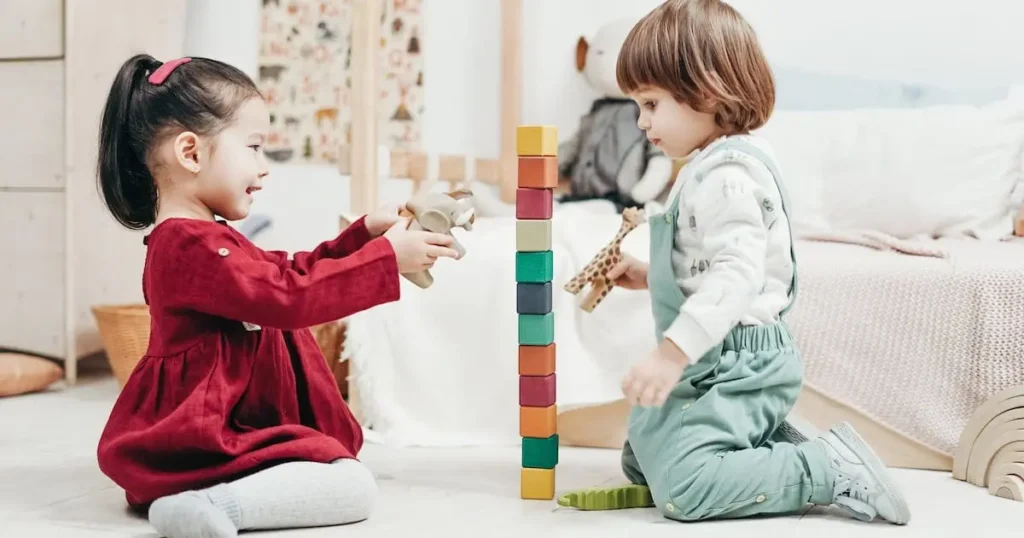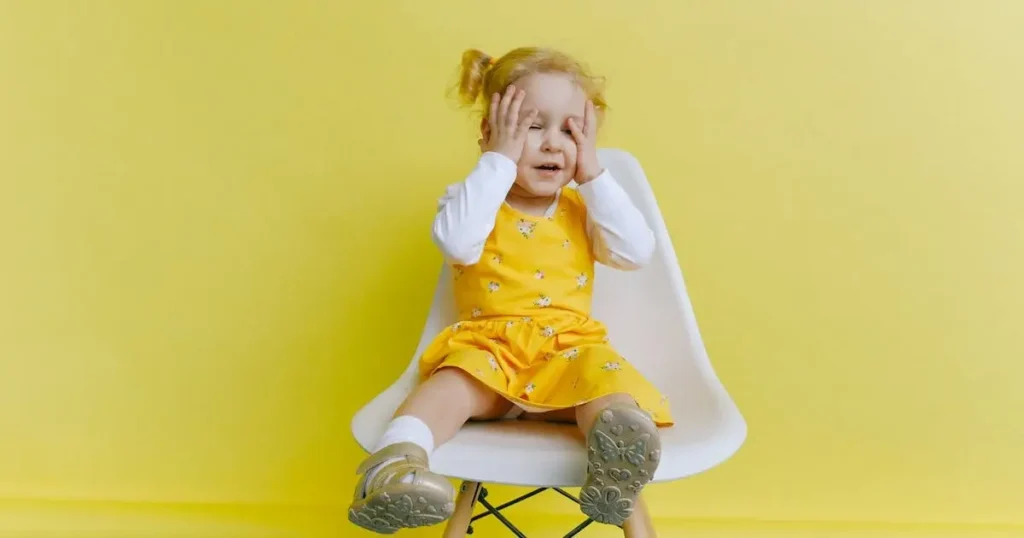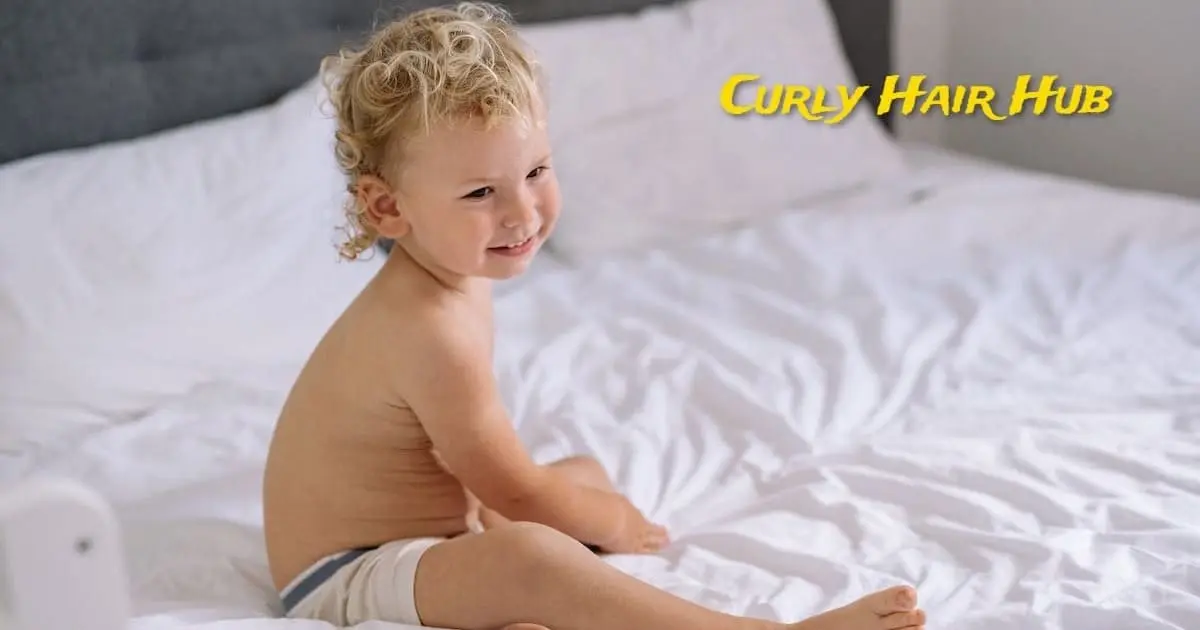Curly hair tendencies often run in families, but environmental factors and changes as children grow can also impact texture. Paying attention to signs around your child’s curl pattern development can help provide clues into whether their curls are here to stay.
Determining whether your child’s hair will stay curly or change over time involves a combination of genetic and environmental factors. Here are some key considerations:

Genetics
Look at the hair types of both parents and their extended families. If there is a history of curly hair on either side, there’s a higher chance your child will have curly hair as well. However, it’s important to note that genetics can be unpredictable, and variations in hair texture can occur.
Observation
Pay attention to your child’s hair during their early years. Hair texture can change as they grow, and some children might experience a shift in their hair type during puberty.
Infant Hair
Many babies are born with fine, straight hair that may change over time. The texture of their hair can transform as they get older, and you may notice curls developing.
Puberty
Hormonal changes during puberty can affect child’s hair texture. Some individuals experience a shift from straight to curly or vice versa during this time.
Hair Care Practices
The way you care for your child’s hair can impact its texture. Using harsh chemicals, frequent heat styling, or tight hairstyles may alter the natural curl pattern.
Hair Porosity
Hair porosity, or the hair’s ability to absorb and retain moisture, can affect its appearance. Curly hair tends to be more porous, so if your child’s hair is naturally more absorbent, it may lean towards being curly.
Consultation with a Professional
If you’re uncertain about your child’s hair type or have concerns, consider consulting with a hairstylist who specializes in curly hair. They can provide insights and recommendations based on the specific characteristics of your child’s hair.
Remember that hair can change over time, and individual experiences may vary. Embrace and celebrate your child’s unique hair texture, and if they do have curly hair, there are numerous resources and products available to help maintain and enhance their beautiful curls.
What Age Does Curly Hair Texture Become Permanent?
Curly hair texture starts to lock in and stabilize around 3 to 5 years old. Prior to this age range, changes in curl pattern are common as children’s hair follicles and structure continue to mature. Around the preschool years, a child’s natural curl tendency becomes more evident if it’s going to persist long-term.
Some key signs your child’s curly or wavy texture will remain permanent after ages 3 to 5:
- Curl pattern remains consistent month to month
- Hair maintains curl formation without heat styling or products
- Texture runs in parents’ or family members’ hair
However, exceptions can occur. Hair changes throughout childhood are still possible due to shifts in weather, health, nutrition and more. Continuing to foster strong hair health habits supports consistency.
Do Curls Loosen Up Or Fall Out As Children Grow?
It’s common for very tight, coiled curls to loosen slightly over time as children grow. However, true curly and wavy textures that are genetic typically won’t fall out or straighten substantially.
What impacts curl loosening?
Weather and seasonal changes: Exposure to new humidity, heat and sunlight levels can temporarily relax tight coils.
Hair weight and length: Added hair weight stretches out curl formation. Trims restore bounce.
Swimming or chlorine exposure: Chemicals and moisture manipulation loosen curls.
Onset of puberty: Hormonal shifts sometimes relax curl intensity mildly.
If curls almost fully “fall out,” the curl pattern likely wasn’t permanent genetically to begin with. These situations are rare after a textured pattern has been established for a few years.
At What Age Can You Perm Or Chemically Treat Curly Hair?

The age at which you can perm or chemically treat curly hair can vary, and it’s important to consider a few factors before deciding to undergo such treatments for a child:
Physical Maturity
Chemical treatments can be harsh on hair, and the hair structure may not be fully developed in younger children. It’s generally recommended to wait until a child’s hair is more mature before introducing chemical treatments.
Parental Consent
If the child is a minor, it’s crucial to have parental consent before applying any chemical treatments to their hair. Parents should be informed about the potential risks and aftercare requirements associated with such treatments.
Professional Consultation
Seek advice from a professional hairstylist or a licensed cosmetologist experienced in chemical treatments. They can assess the child’s hair condition, texture, and overall suitability for the specific treatment.
Hair Health
Ensure that the child’s hair is in good health before applying any chemical treatment. Chemically treating hair that is already damaged or compromised can lead to further issues.
Responsibility and Aftercare
Chemical treatments require proper care and maintenance. Consider whether the child can follow the necessary aftercare routines and precautions associated with perming or chemical treatments.
Temporary Alternatives
For younger individuals who may want to experiment with different looks without a permanent commitment, consider temporary alternatives like heat-free styling methods, braids, twists, or other non-chemical options.
While there isn’t a specific age limit for chemical treatments, it’s crucial to approach such decisions with caution and prioritize the health and well-being of the child’s hair. Always consult with a professional stylist who can provide personalized advice based on the child’s unique hair characteristics and conditions.
I advise waiting until at least age 10 to 12 before chemically altering or perming tight curls for straightening or added curl.
| Age 3 to 7 | Avoid chemical treatments |
| Age 8 to 11 | Consult a specialist first |
| Age 12+ | Chemical treatments may be OK |
Younger than age 8, chemical services can damage the scalp and developing hair. Around mid-childhood at the earliest, professional perms and relaxers applied minimally might be considered. Take great care and consult stylists familiar with treating kids’ curls.
What Role Does Puberty Have On Curly Hair Changes?
Puberty shifts between ages 10 to 14 can indirectly impact curl pattern. Hormonal changes during this time contribute to oil and moisture level fluctuations which can relax tight coils. Combined with growth spurts increasing hair weight, curls may widen and lengthen some.
However, puberty related texture shifts tend to be temporary. Assuming the child’s base curl pattern is genetically embedded by this age, curl intensity often rebounds after puberty’s conclusion. Managing moisture levels can help curls re-stabilize.
Can I Predict If My Child’s Hair Will De-Frizz Or Stay Frizzy?

Genetic frizz tendencies often persist through childhood into adulthood. Very tight coils with numerous fly-away strands tend to be hallmarks of lasting frizz potential.
To estimate if extreme frizz will remain:
- Assess bio parents’ & family members’ frizz levels
- Note curl diameter – smaller coils increase frizz risk
- Check if frizz lasts with styling products or humidity changes
Though some frizz prevention is possible through moisturizing routines and styling aids, enduring naturally frizzy hair usually continues as a trait.
Do Hair Or Scalp Conditions Cause Permanent Curl Loss?
Certain scalp conditions can contribute to temporary or permanent curl loss if untreated:
Alopecia areata: Autoimmune disorder causing patchy hair loss. Possibly reversible through steroid treatments.
Scalp ringworm: Fungus infection leading to brittle breakage and shedding. Treated with anti-fungal medications.
Psoriasis: Autoimmune disease creating raised, scaly scalp patches. Topical ointments help most cases.
In addition, overuse of chemical straightening treatments often causes irreparable curl damage over time.
Work with doctors to accurately diagnose any suspected hair or scalp conditions. Taking a hair health history to your pediatrician can uncover causes of texture changes.
Should I Style Tight Curls Differently Than Loose Curls?
Yes, tight coils and loose waves require different care to maintain optimal moisture, appearance and curl formation.
| Tight Curls | Loose Waves |
| – define curls in small sections | – style by twisting bigger sections |
| – use heavier sealing products | – lighter leave-ins may suffice |
| – diffuse or air-dry fully | – can air-dry wavy |
| – careful detangling | – wider tooth combs OK |
The needs of coily curls vary greatly from loose waves. Learn techniques specifically tailored to your child’s exact curl type.
What If Only the Bottom Layer Of Child’s Hair Is Curly?

Seeing only the underlayer of hair forming curls is common when hair is partially wavy or transitioning texture changes.
Some explanations for bottom-only curl layers:
Partially wavy hair
The bottom sections exhibit the most curl due to increased weight and length stretching out the top layers. Even hair with very minimal wave will curl up at the ends.
New curl development
When transitioning from straight to wavy, new curl formation often begins at the ends. As texture change progresses, waves will develop higher up the hair shaft over time.
Improper curl care
If the bottom curls maintain definition but the tops lack hydration, moisture loss only allows the underparts to curl. Deep conditioning and gel application improvements can help curls uniform through all layers.
Focus curl care on the lower lengths while monitoring the upper layers for added wave development.
Conclusion
Assessing whether your child’s distinctive curly texture will endure over time requires observing indications of enduring genetic curl patterns manifesting during preschool years. The sustained formation of curls, coupled with limited reliance on heat styling or products, suggests a natural texture meant to persist in your child’s hair. While accounting for influences like weather variations, age-related shifts, and health fluctuations during childhood, the inherent tendencies of curly and wavy child’s hair truly come into prominence from toddlerhood through the grade school years.
Exercise patience during any shifts in the curl pattern while consistently fostering habits that promote healthy moisture retention in your child’s hair. If tightly coiled ringlets or gentle waves have solidified by your child’s fifth birthday, you can reasonably anticipate enjoying those luxurious locks for an extended period. By addressing their unique requirements with appropriate care, the natural texture of your child’s hair becomes a source of pride and confidence, evolving into an effortless style statement.
Frequently Asked Questions
What if my child’s curls completely straighten out during the summer or swimming season?
Some coil relaxation due to weather or chemical exposure during warmer months can occur. But if texture is entirely gone, the base curl pattern likely wasn’t permanent genetically. Provide deep conditioning focus during this time to support hydrations levels against elements like chlorine.
Why does my curly child suddenly have one straight patch of hair?
Consistent stick-straight sections on otherwise curly heads may indicate an underlying scalp issue. Skin conditions like ringworm or alopecia areata can cause texture changes and hair breakage in concentrated areas. Consult doctors to diagnose any irregular hair or scalp changes.
Can I alter my curly child’s hair type with vitamins or at-home treatments?
Permanently changing genetic hair texture at home is very difficult, risky and not advised. The healthiest goal is maintaining your child’s hair texture integrity based on what type of curls or waves they develop naturally. Support their hydration and curl formation without relying on potentially damaging chemical interventions whenever possible.
Should I avoid trims if I want my kids’ curls to grow longer?
Regular trims are actually vital for encouraging longer locks, especially for curly kids! Blunt ends and removed split ends allow curls to hang at their maximum lengths without breaking mid-strand. Aim for a half-inch trim every 6 to 8 weeks to support growth.
How do I add volume to flat, limp curls on my child’s hair?
Encourage fuller strands by creating lots of lift at the root area when styling. Use clips or velcro rollers to boost curl bases upward. Also incorporate volumizing shampoos and mousse products made to plump up flattened sections with added grip and hold. Target flat patches by finger fluffing pieces while diffusing for an extra punch of volume.
